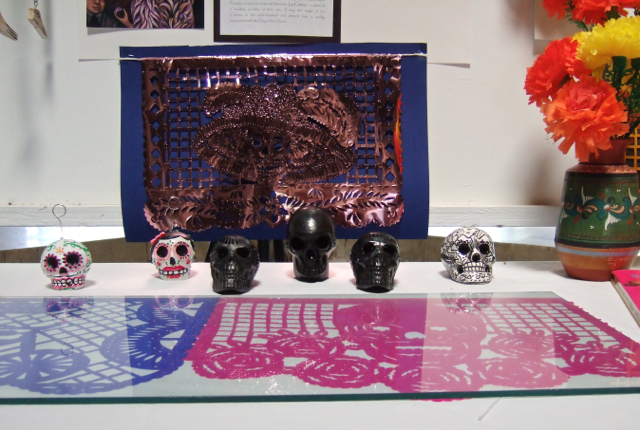
David Hamada, botanist and the garden’s executive director, was in Mexico last year for the holiday and he displayed photos, posters, ceramics and other memorabilia used in the celebration.
“It is nothing scary. It’s not about mourning dead ancestors but celebrating that you had them,” Hamada said.
Dia de los Muertos was first commemorated by the Aztec Indians, Hamada said, and it is still an important holiday, especially in Mexico, Central America and some U.S. communities. The Aztecs believed in life after death and followers of the tradition celebrate life and ancestors on Nov. 2 with altars, religious observance, music and dance.
Hamada, who said he is “half Mexican,” described the significance of the symbols – skulls (calveras), altars (ofrendas) and flowers.
Skulls are a symbol of the Day of the Dead, and tiny sugar skulls are special treats for children. The most popular skull, symbolizing the upper class, is La Catrina, a woman with an elaborate hat.

The importance of flowers in Mexican celebrations cannot be overestimated. According to Hamada and the Mexican Secretariat of Agriculture, Livestock, Rural Development, Fisheries and Food, farmers grew more than 15,000 tons of flowers in 2012.
“Plants play a significant role in the daily lives of the cultures that developed around them” said Hamada, a botanist.
The style and construction of the traditional altars vary from village to city according to Hamada. In cities, the culture and folk art are the focus. Small town ofrendas contain the deceased’s favorite food and drink for their journey, which can take up to four years, according to Aztec lore. Warriors and mothers who died in childbirth get to heaven sooner.
Hamada described the ofrenda he created for his grandmother. His altar was covered with fruit, flowers, ceramic pottery, pictures of Our Lady of Guadalupe and photos of his grandmother. He included her favorite items – pineapple beer, sugar cane and watermelon. The traditional bread (pan de muertos), a pitcher of water, candles and a brightly colored banners represented the four elements – earth, wind, fire and water. A banner was made of “papel picado,” or picked paper – intricate designs cut into squares of paper.
The Day of the Innocents (Dia de los Inocentes) is Nov. 1. On that day, the lives of deceased children are commemorated. Other cultures celebrate Nov. 1 and 2 as All Saints Day and All Souls Day respectively. Hamada said some cultures roll Halloween into the celebration.
About 30 people attended the presentation and some sampled the bread and pineapple beer. Don Bailey said he has studied the Mexican tradition but didn’t know before that the skeletons in drawings and other folk art are used to mock politicians.
Patricia King said she was interested to learn about the “varied visuals,” and the importance of marigolds. She called the process of creating the picked paper “amazing.”
Former president of the SGVBG, Sandi Savage, compliments Hamada on his presentation.
“This was very educational. Learning about all of this – now I know why all the ghosts are in my house,” Savage said.





